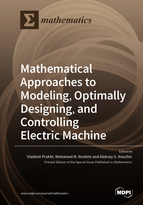Mathematical Approaches to Modeling, Optimally Designing, and Controlling Electric Machine
A special issue of Mathematics (ISSN 2227-7390). This special issue belongs to the section "Engineering Mathematics".
Deadline for manuscript submissions: closed (30 November 2021) | Viewed by 40945
Special Issue Editors
Interests: energy efficiency; electric machines; electric motors; electric generators; electric drives; gearless generators; gearless motors; high-speed electric machines
Special Issues, Collections and Topics in MDPI journals
Interests: synchronous reluctance machine; permanent magnet assisted synchronous reluctance motors; field-oriented control; winding function; harmonic analysis; star-delta; magnetic steel grade and optimization techniques
Special Issues, Collections and Topics in MDPI journals
Interests: control systems of electric drives; hybrid powertrains; real-time communications
Special Issues, Collections and Topics in MDPI journals
Special Issue Information
Dear Colleagues,
An electric machine is the main core of electric drives in industrial, transportation, and domestic applications as well as in traditional and renewable energy generation systems, for example, in wind and hydro generators. A pre-experimental evaluation of the electric machine performance for a given application is always based on a mathematical model. The mathematical model accuracy and methodology vary depending on the application requirements. In addition, the methods of optimal design of electric machines significantly facilitate reaching these requirements. Most of the requirements for electrical machine design are in contradiction to each other (reduction in volume or mass, increase in efficiency and power density, etc.). Therefore, finding the optimal design that will achieve all of them can be a massive task due to a large number of varied parameters whose effects on the machine performance and quality of the design are strongly coupled. Therefore, the optimal design methodology of electric machines is always necessary. The reliable and efficient operation of the electrical machine is impossible without precise control. Therefore, the control strategies, state observers, and their mathematical models which help to check the approaches of optimal and efficient control are important.
This Special Issue aims to collect papers reporting the mathematical approaches to modeling, optimal design, and control of electric machines. The main topics of this Special Issue include, but are not limited to:
- Analytical models (electromagnetic, thermal, etc.) of electric machines
- Numerical models (finite element method, boundary element method, equivalent circuits, etc.) of electric machines
- Multi-physics models of electric machines
- Lifetime modeling of electric machines
- Losses modeling of electric machines
- Optimal design methodologies of electric machines
- Optimization techniques for fast and efficient optimal design of electric machines
- Offline and online methods for identification of electric machine parameters
- Field-oriented control and direct torque control
- Model predictive control of electric machines
- Self-sensing control of electric machines
- Robust control of electric machines
- Optimal control techniques of electric machines
Dr. Vladimir Prakht
Dr. Mohamed N. Ibrahim
Dr. Aleksey S. Anuchin
Guest Editors
Manuscript Submission Information
Manuscripts should be submitted online at www.mdpi.com by registering and logging in to this website. Once you are registered, click here to go to the submission form. Manuscripts can be submitted until the deadline. All submissions that pass pre-check are peer-reviewed. Accepted papers will be published continuously in the journal (as soon as accepted) and will be listed together on the special issue website. Research articles, review articles as well as short communications are invited. For planned papers, a title and short abstract (about 100 words) can be sent to the Editorial Office for announcement on this website.
Submitted manuscripts should not have been published previously, nor be under consideration for publication elsewhere (except conference proceedings papers). All manuscripts are thoroughly refereed through a single-blind peer-review process. A guide for authors and other relevant information for submission of manuscripts is available on the Instructions for Authors page. Mathematics is an international peer-reviewed open access semimonthly journal published by MDPI.
Please visit the Instructions for Authors page before submitting a manuscript. The Article Processing Charge (APC) for publication in this open access journal is 2600 CHF (Swiss Francs). Submitted papers should be well formatted and use good English. Authors may use MDPI's English editing service prior to publication or during author revisions.
Keywords
- electric machines
- electric motors
- electric generators
- electric drives
- mathematical models of electric machines, optimal design, optimal control techniques








